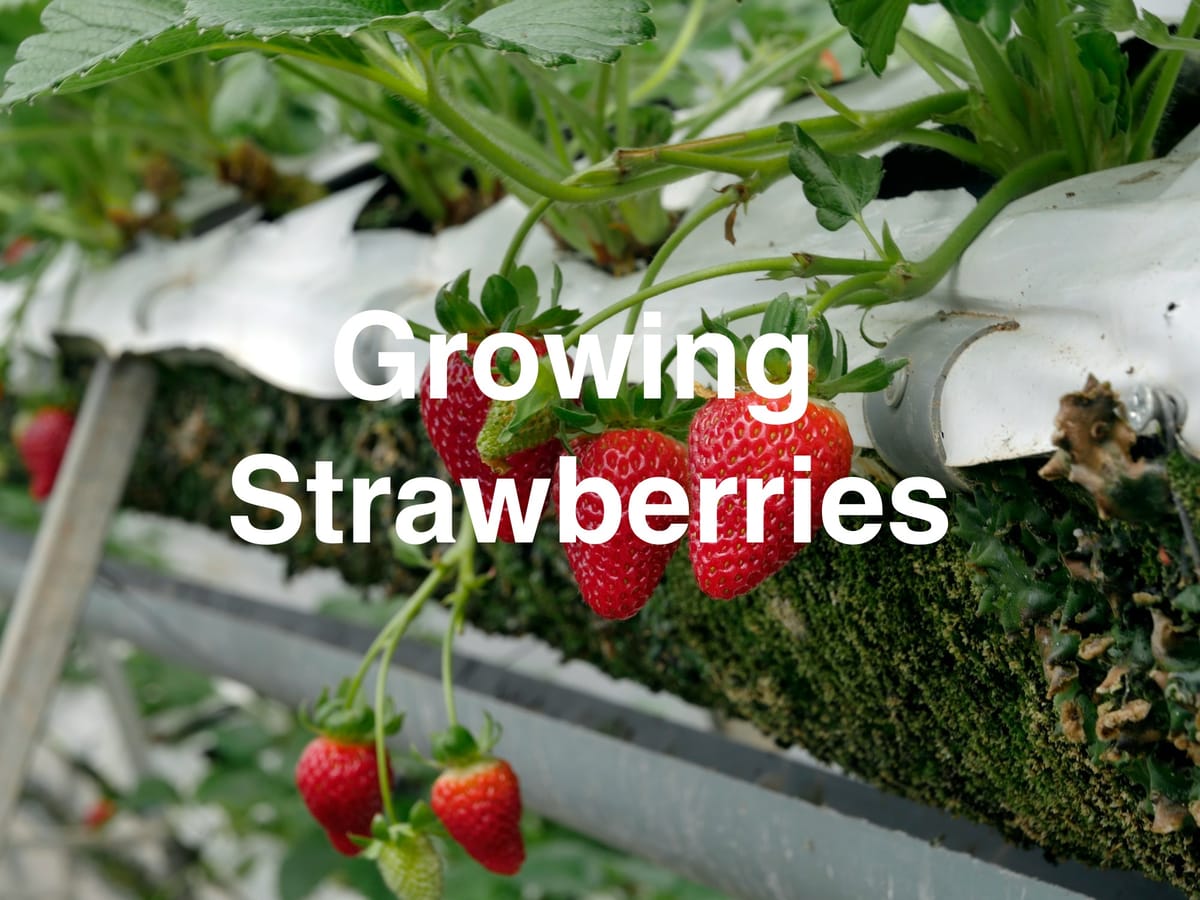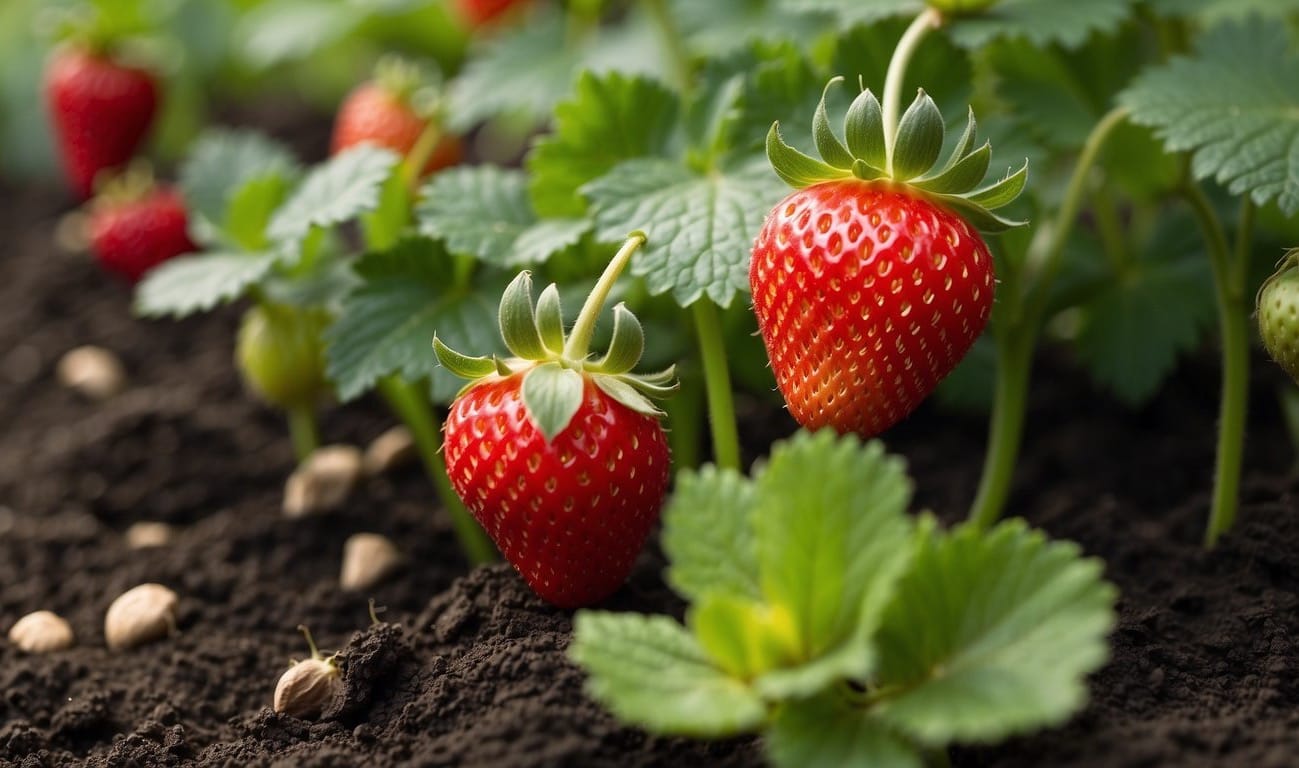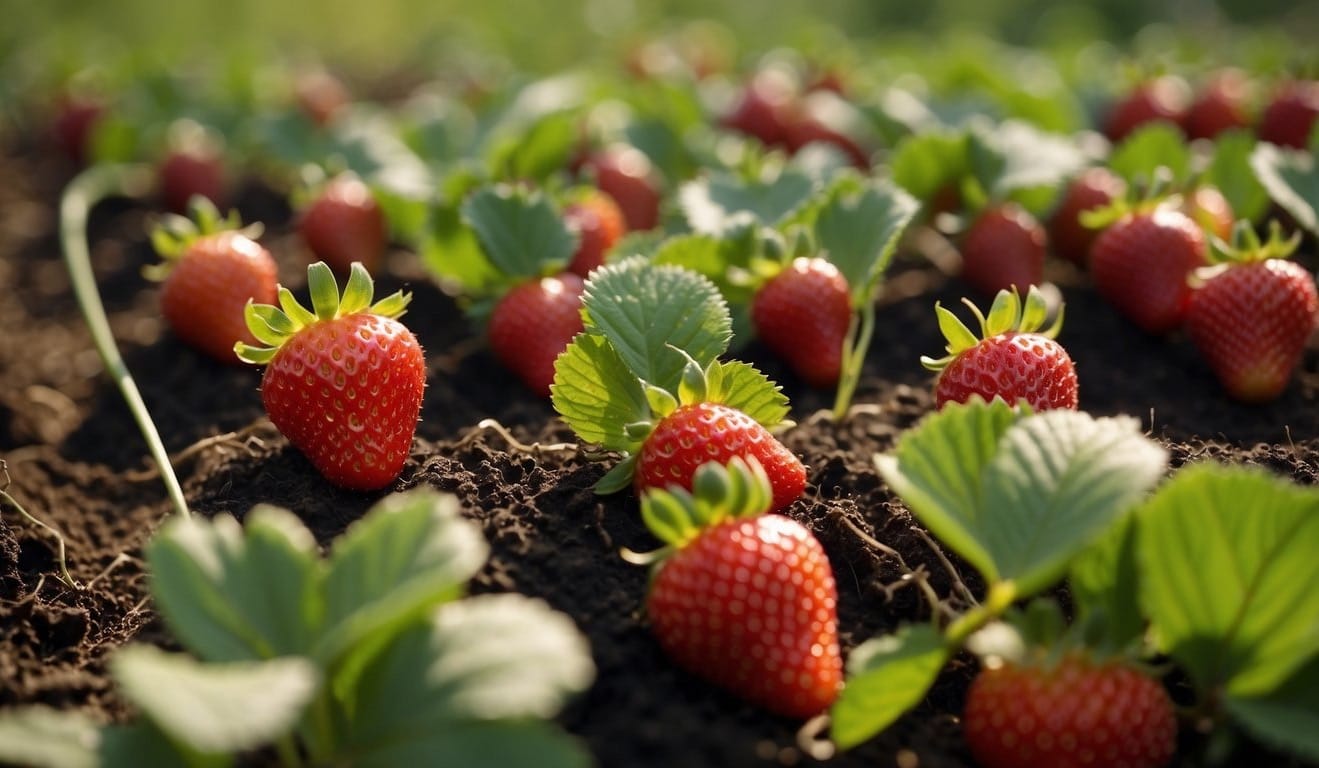How to Grow Strawberries
Growing strawberries is a rewarding endeavor that combines ease of care with the delight of harvesting your own sweet, sun-ripened fruit.

Beginning the journey of growing strawberries starts with selecting the right variety that matches your regional climate and personal taste preferences.
Certain varieties excel in containers and hanging baskets, while others are bred for large fruit or resistance to specific diseases, ensuring there's a type for every gardener's goals and conditions.
Preparing your garden for strawberries requires attention to soil, sunlight, and spacing.
These berries prefer well-drained soil rich in organic matter and a sunny location to thrive.

Proper spacing and the use of mulches can help to prevent diseases and keep weeds at bay.
When planting, you may opt for bare root plants or potted plants. You can also follow specific strategies like the hill or matted row system to optimize your space and yield.
Key Takeaways
- Selecting the right strawberry variety is crucial for success.
- Preparation of soil and planting area influences plant health and productivity.
- Proper spacing and planting techniques are essential for maximizing yield.
Choosing the Right Variety
When you're ready to start your strawberry garden, selecting the right variety is crucial for ensuring a bountiful harvest.
Strawberries come in mainly three varieties: June-bearing, everbearing, and day-neutral. Here's how they differ:
- June-bearing: These types produce a large crop typically in early summer. Perfect if you want a lot of berries at once, ideal for canning or making jam.
- Everbearing: Expect several smaller harvests throughout the growing season. Suitable for fresh eating as berries come in steady, smaller batches.
- Day-neutral: Similar to everbearing, but produces fruit continuously through the growing season, regardless of day length.
Your local climate is a significant factor in variety selection. For instance, Alpine strawberries, known for their smaller fruits and unique flavor, may tolerate cooler zones better.
| Variety Type | Harvest Time | Berry Size | Climate Suitability |
|---|---|---|---|
| June-bearing | Early summer | Larger | Varied, check zone |
| Everbearing | Multiple harvests | Medium-small | Varied, check zone |
| Day-neutral | Continuous | Medium-small | Varied, check zone |
| Alpine | Variable | Small | Cooler climates |
Be sure to also look for varieties that show resistance to local plant diseases. This proactive step can minimize problems during the growing season.
When in doubt, local nurseries or agricultural extensions can be valuable resources for recommending varieties well-suited to your area.
Remember, healthier plants lead to more delicious strawberries for your table.
Preparing Your Garden

Before planting strawberries, the preparation of your garden is critical to the success of your crop.
Focus on optimizing soil conditions and selecting the best location for adequate sunlight and temperature regulation.
Soil Conditions
Your strawberries demand rich, loamy, and well-drained soil with a slightly acidic pH between 5.3 and 6.5.
Follow these specific steps to ensure the soil is ready for planting:
- Test the soil pH: Utilize a soil test kit to determine the pH level and make adjustments if necessary.
- Enrich the soil: Work in plenty of compost or well-rotted manure to enhance fertility.
- Ensure good drainage: To prevent waterlogged roots, which can cause plant diseases, consider planting in raised beds if drainage is an issue.
Choosing a Location
The right location is crucial for the health and productivity of your strawberry plants. They need a spot that will provide them with:
- Full sun: Aim for a location that receives 6-8 hours of direct sunlight per day.
- Protection from extreme temperatures: While strawberries thrive in warm conditions, they also need protection from extreme heat.
- Space for growth: Whether in a garden or containers, ensure ample space for runners and good air circulation between plants.
Planting Strategies

Successful strawberry cultivation begins with understanding the optimal time for planting as well as appropriate planting techniques.
Your goal is to provide a strong foundation for the plants to establish and thrive.
Planting Time
Early Spring: You should plant your strawberry plants as soon as the ground is workable during early spring.
If temperatures are consistently above 40°F (4.4°C), it's a good signal that it's time to plant. Avoid late spring plantings as they may not allow strawberries enough time to establish before the heat of summer.
Planting Techniques
Soil Preparation: Before planting, ensure your soil is well-drained and slightly acidic, with a pH between 5.0 and 7.0, ideally 5.8 to 6.2.
Rich, loamy soil amended with compost or well-rotted manure will give your strawberries the best start.
Planting Process: When planting strawberry plants, keep the following points in mind:
- Plant Spacing: Space plants about 18 inches apart to leave room for runners. Arrange the rows about 4 feet apartto allow for easy maintenance and harvesting.
- Crown Placement: Plant strawberries so the base of the crown is at soil level; the crown should be exposed to the air.
- Watering: After planting, water the strawberry plants with 1-2 inches of water per week during the growing season to maintain moist soil.
Runner Management: Strawberry plants will produce runners.
To encourage a strong parent plant and potentially new plants, you may choose to let some runners establish. However, for larger fruit production on the main plant, consider trimming the runners.
Caring for Strawberry Plants

Proper care is crucial for healthy growth and fruit production in strawberry plants. This includes maintaining appropriate moisture levels, protecting plants with mulching, and supplying essential nutrients through feeding and fertilization.
Watering and Moisture
Consistency is key in watering your strawberry plants. They require:
- 1 to 1.5 inches of water per week, especially during fruit production.
- Regular watering is essential to maintain moist, but not waterlogged, soil.
Monitor soil moisture closely and water early in the day to allow leaves to dry and prevent fungal diseases.
Mulching
Mulching offers numerous benefits, such as:
- Preventing moisture loss: Apply a 2-3 inch layer of mulch around plants.
- Types of mulch:
- Straw mulch is ideal, as it keeps the fruits clean and insulates the soil.
- Pine needles can also be used; they help to add slight acidity to the soil.
Mulch should be refreshed as needed to maintain its protective and moisture-retaining properties.
Feeding and Fertilization
Feeding your strawberry plants is necessary to ensure vigorous growth. Use:
- An all-purpose fertilizer shortly after planting.
- Compost or well-rotted manure can enrich the soil with organic matter and nutrients.
During the growing season, a balanced fertilizer rich in nitrogen should be applied to sustain plant development and fruit production.
Avoid over-fertilization, which can lead to excessive leaf growth at the expense of fruit yield.
Protecting from Pests and Diseases

In your quest to grow healthy strawberries, it's crucial to shield them from pests and diseases that can mar your crop.
By taking proactive steps and employing effective strategies, you can ensure your strawberries thrive.
Common Pests
To fend off common pests, such as slugs, birds, and various bugs, implement these targeted methods:
- Birds: Use netting to cover your strawberry plants, ensuring birds can't reach the fruit.
- Slugs: Set up beer traps or sprinkle diatomaceous earth around the plants to deter these pests.
- Bugs: Apply organic pesticides when necessary or introduce natural predators like ladybugs to control aphid populations.
Disease Prevention
Preventing diseases like powdery mildew and verticillium wilt is essential for the health of your strawberry plants. Follow these preventative practices:
- Powdery Mildew: Ensure adequate air circulation by not overcrowding plants. Also, water the soil, avoiding the leaves.
- Verticillium Wilt: Choose resistant strawberry varieties and practice crop rotation.
- Frost Protection: Apply mulch around the plants to protect them from frost damage.
- Weed Control: Keep the garden bed free of weeds to reduce competition and minimize disease spread.
Staying vigilant and adopting these protective measures will give your strawberries a strong defense against pests and diseases.
Maximizing Your Yield

When growing strawberries, your goal is to achieve the highest possible yield of succulent fruit.
Understanding Strawberry Production
To maximize strawberry yield, it’s essential to select strawberry varieties best suited for your climate.
You should also understand the fruiting habits of your plants. There are two main types of strawberry plants: June-bearing and day-neutral.
June-bearing strawberries produce a large, concentrated crop typically in late spring to early summer. Meanwhile, day-neutral varieties can produce fruit throughout the growing season.
June-bearing strawberries should be planted in early spring as soon as the soil is workable. To encourage robust production, focus on the first year of growth by removing all the blossoms. This directs the plant’s energy towards establishing a strong root system. In the subsequent years, you can allow the plants to fruit.
The yield of each plant varies, but generally, you can expect between 25 to 50 individual strawberries per plant over the season. This translates to about one to two quarts. Enhancing your practices with the following strategies can significantly increase these numbers:
- Soil preparation: Ensure the soil is well-tilled, up to 8-10 inches deep, and enriched with compost, manure, and balanced fertilizer.
- Watering: Maintain consistent moisture levels without oversaturating by watering regularly.
- Mulching: Apply a 2- to 3-inch layer of mulch around plants to retain soil moisture, moderate soil temperature, and suppress weeds.
- Runner management: For june-bearing plants, removing runners can direct more energy into fruit production. However, if you wish to propagate more plants, allow runners to take root.
- Renovation: After harvesting, June-bearing strawberry beds should be thinned and renovated to prevent overcrowding and promote vigorous growth for the next season.
Seasonal Care Guide

To ensure a fruitful yield, your care for strawberries must adapt with the seasons. This guide outlines specific maintenance tasks throughout the year that will help your strawberry plants thrive.
Spring Care
In early spring, as soon as the ground is workable and consistently above 40°F (4.4°C), it’s time to plant or uncover your strawberries.
Ensure proper air circulation and adequate space to prevent fungal diseases. Mulching with straw or pine needles can protect the plants from sudden temperature changes and keep the soil moist.
- Mulching: Apply light mulch to protect new growth from frost.
- Watering: Increase as plants start actively growing.
- Spacing: Allow 18 inches between plants and 4 feet between rows.
Summer Maintenance
Summer is crucial for strawberry care. Your strawberries need around 6-8 hours of sunlight daily.
Regular watering maintains the necessary moisture level without causing waterlogging. Check for pests and disease regularly, and remove any weeds to reduce competition for nutrients.
- Sunlight: Minimum 6-8 hours of full sun per day.
- Watering: Consistent moisture, especially during dry periods.
- Weeding: Keep beds free from weeds.
Autumn Preparations
Autumn care prepares strawberries for winter. As the yield tapers off and leaves begin to yellow, reduce watering. This is also the time to clear any dead leaves or debris, which can harbor pests over the winter.
- Watering: Gradually decrease to harden plants for winter.
- Cleaning: Remove dead leaves and debris to minimize pests and diseases.
Winter Protection
Protection during winter is essential for overwintering strawberries. After several frosts, apply a thicker layer of mulch to insulate the plants from cold. Ensure that the crown of the plant is not buried to avoid rot.
- Mulching: Thick layer after several frosts, but don’t cover crowns.
- Inspection: Check mulch periodically to maintain coverage without smothering plants.
Frequently Asked Questions
What is the best way to grow strawberries?
For optimal growth, plant your strawberries in well-drained, slightly acidic soil with a pH between 5.0 and 7.0. Position them so that the crown is at soil level and exposed to avoid rot. Ensure they receive at least 6-8 hours of direct sunlight daily and provide consistent watering.
How can I grow strawberries indoors?
Growing strawberries indoors requires containers with ample drainage and a location that receives sufficient sunlight or supplemented with grow lights. Indoor strawberries should have 6-8 hours of light and be planted in high-quality potting mix.
What are the steps to growing strawberries from runners?
To grow strawberries from runners, wait until the runners have rooted, then snip them off. Plant these young plants in soil where the crowns are level with the soil line and keep the soil moist as they establish themselves.
How long does it take for strawberries to bear fruit?
Strawberries typically bear fruit within 4-6 weeks after flowering, depending on the variety and growing conditions. Everbearing strawberries can produce fruit from early summer through the first frost.
Can you grow strawberries from the fruit, and if so, how?
Yes, you can grow strawberries from seeds extracted from the fruit’s outer skin. Allow the seeds to dry, then sow them on the surface of the soil and keep them moist until they germinate.
What considerations are there for planting strawberries in pots?
Choose pots that are at least 18 inches wide with adequate drainage. Use a potting mix designed for containers.
Place the pots in a sunny location. Monitor moisture levels closely. Potted strawberries may require more frequent watering.


